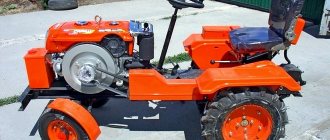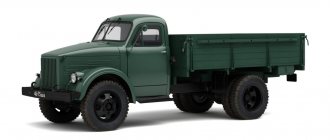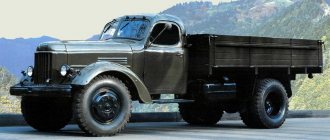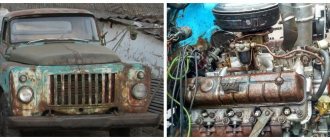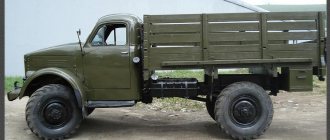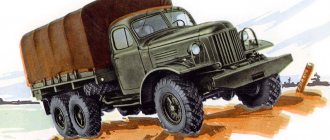For the transportation of gasoline and diesel fuel, both in the Soviet Union and in Russia, all kinds of fuel trucks based on various trucks were and are often used. Each fuel tanker consisted of a closed tank for transporting gasoline mounted on a truck chassis. GAZ, ZIL, KamAZ, MAZ vehicles were and still are used as chassis. Each truck was provided with a container of a certain volume.
Fuel truck GAZ-53
The main feature of these tank trucks is the chassis produced by the Gorky Automobile Plant labeled GAZ-53, which was produced in serial form from 1961 to 1993. They are third-generation medium-duty vehicles from the GAZ model range with a similar payload capacity, which over the years of production have exceeded a total number of more than 4 million units. Having become the most popular Soviet truck, this vehicle had many modifications - dump trucks, truck tractors, fire trucks, milk tankers, fuel tankers, etc.
The advantages of using the GAS base for transporting gasoline products come from the following factors:
- Reliability of the machine itself;
- Simplicity of the device and, as a result, availability of routine repairs;
- Long engine life - up to 400 thousand kilometers;
- Possibility of accommodating up to 3 people in the cabin, which allows personnel to change control and participate in joint actions in the event of an emergency;
- All-metal structures ensuring safe maintenance;
- Cheapness of spare parts used in repair work.
An elliptical cross-section tank is installed on the base chassis, giving the vehicle the greatest compactness and maneuverability when moving through urban areas. At the same time, the vehicle is adapted to the conditions of the Russian climate and roads, both in terms of the cargo base and the tank tank.
Photo of a fuel truck based on GAZ 53
GAZ-52 engine lubrication system
The GAZ-52 engine lubrication system is combined;
Lubrication is carried out under pressure and splashing. The lubrication diagram is shown in Fig. 8. The oil taken by the pump from the oil sump, through the oil receiver 16, enters under pressure into the coarse oil filter 15 and then into the longitudinal oil channel of the cylinder block.
From the longitudinal oil channel, oil flows through the transverse channels of the block to the main bearings of the crankshaft and to the camshaft bearings.
Oil from the main bearings of the crankshaft is supplied to the connecting rod journals through channels made in the body of this shaft. The camshaft gears are lubricated by a pulsating stream of oil coming from the front camshaft bearing through tube 1.
Rice. 8. Diagram of the GAZ-52 engine lubrication system
1 — lubrication tube for timing gears; 2 — oil channel to the bearings of the crankshaft and camshaft; 3 — oil pump gears; 4 — oil radiator valve; 5 - safety valve; 6 — oil radiator; 7 - plug; 8 - gasket; 9 - spring; 10 - plunger; 11 — crankcase ventilation filter; 12 — fine filter; 13 — bypass valve of the coarse filter; 14 — coarse filter handle; 15 — coarse filter; 16 — oil receiver; 17 - drain plug
There are two grooves in the front journal of the camshaft, with the help of which the tube is connected to the channel in the block twice for each revolution of the shaft.
The camshaft thrust flange is lubricated through two holes in the front bearing journal located at an angle of 90°.
The cylinder surfaces, piston pins, camshaft lobes, lifter plates and valve stems are lubricated by splashing oil flowing from the crankshaft and camshaft bearing clearances.
The cylinder walls are also lubricated by streams of oil ejected from the holes in the lower connecting rod heads.
The lubrication system of the GAZ-52 engine includes an oil sump, an oil receiver, an oil pump, coarse and fine oil filters and an oil cooler. The oil system capacity, including filters and oil cooler, is 7 liters.
Oil is poured through the oil filler pipe, closed with a filter cap. The oil level in the crankcase is checked using a dipstick placed in a tube on the left side of the engine.
There are marks on the rod: P - upper limit and 0 - lower limit. When the engine is running, the oil level should be above the upper half of the distance between marks P and 0.
A drop in the oil level below the 0 mark is dangerous, since oil will not flow into the bearings and they will melt. When the oil level exceeds the P mark, the spark plugs are filled with oil and the piston rings quickly coke.
Oil sump of GAZ-52 engine
The oil sump is steel, stamped. The crankcase capacity up to the P mark on the indicator is 4.7 liters. Inside the crankcase there are partitions that protect the oil from splashing when driving. The oil cooler drain pipe is attached to the left side of the crankcase with three rivets.
Along the entire flange, the crankcase is sealed with cork gaskets using twenty bolts with which it is attached to the lower plane of the block. At the bottom of the crankcase there is a hole for draining the oil, into which a plug with a sealing washer is screwed.
Oil receiver. The threaded end of the receiving tube is screwed into the lower flange of the block and secured with a nut.
A filter mesh is attached to the body using a spring; if it becomes clogged, oil can pass through the gap between the body and the mesh lining.
Spare parts for Lviv loaders 4014, 40814, 40810, 4081, 41030 are shipped to all cities of Russia: Kemerovo, Ekaterinburg, Chelyabinsk, Novosibirsk, Ulan-Ude, Kirov, Perm, Krasnoyarsk, Irkutsk, Omsk, Barnaul, Tomsk, Bratsk, Tyumen, Lysva, Novokuznetsk, Miass, Serov, Chita, Berezovsky, Mezhdurechensk, Nizhny Tagil, Biysk, Minusinsk, Satka, Kurgan, Novy Urengoy, Norilsk, Noyabrsk, Oktyabrsky, Orenburg, Orsk, Prokopyevsk, Prokhladny, Pskov, Rubtsovsk, Rybinsk, Ryazan, Salavat, Saransk, Sarapul, Severodvinsk, Sibay, Sochi, Stavropol, Stary Oskol, Sterlitamak, Surgut, Syzran, Taganrog, Tambov, Tobolsk, Ust-Ilimsk, Ukhta, Khabarovsk, Khanty-Mansiysk, Chistopol, Chusovoy, Shadrinsk, Shakhty, Shelekhov , Elektrostal, Elista, Engels, Yakutsk, Vologda, Nizhny Novgorod, St. Petersburg, Belgorod, Orel, Kazan, Rostov-on-Don, Voronezh, Bryansk, Krasnodar, Saratov, Murmansk, Tula, Noginsk, Volgograd, Ivanovo, Penza, Cheboksary, Volzhsky, Yaroslavl, Syktyvkar, Izhevsk, Samara, Makhachkala, Volzhsk, Yoshkar-Ola, Sokol, Ufa, Arkhangelsk, Tver, Podolsk, Ulyanovsk, Smolensk, Togliatti, Vladikavkaz, Petrozavodsk, Kursk, Vladimir, Cherepovets, Naberezhnye Chelny, etc. .
Technical operations for replacing and adjusting assemblies and components of LZA forklifts
Gasoline tanker
Fuel trucks can be of three types: tanker, tank-trailer and tank-semi-trailer. The GAZ 53 fuel tanker is a tank truck, since the fuel barrel is installed directly on the chassis. Unlike other tanks, gasoline tankers carry gasoline or diesel fuel.
Fuel tanker tank for transporting fuel
However, another tank can be used to transport fuel, but the barrel must be thoroughly cleaned from the inside using steam. It is important that the tank meets the requirements for the transport of dangerous goods.
A fuel tanker also refers to a fuel tanker. This equipment is additionally equipped with a fuel nozzle, a drain pump and a fuel meter.
Return to contents
About the areas of application and modifications of the GAZ-53
On its not particularly powerful shoulders, the GAZ-53 nevertheless “rolled” at least half of the entire economy of the Country of Soviets. It's hard to find where this ubiquitous truck has NOT been used. From the “gait” for emergency crews and the “paddy wagon” for criminals to mobile fuel tankers and truck tractors that hauled containers - everything that was not installed on the GAZ-53 chassis!
These cheap, simple and unpretentious trucks have become widespread in agriculture. In the 70s/early 80s of the 20th century, on the average Soviet collective farm, 80% of the truck fleet consisted of GAZ-53. Only in the second half of the 80s did this ratio begin to change towards an increase in the share of ZIL-130, which, by the way, in Soviet times did not cost much more than GAZon.
GAZ-53 of the 60s and 80s both look noticeably different from each other, and in a technological sense these are two quite different trucks. Not only are their engines completely different, but also many other design elements.
After all, over the years of production, the GAZ-53 has experienced three major and many minor upgrades and improvements. The Gorky Automobile Plant tried to promptly respond to “signals from the field” and eliminate problems identified during operation.
Thus, already in the first years of the distribution of the new truck model across the country, it became obvious that the axles from the previous generation - GAZ-51, were no longer suitable for the 53rd, and the 82-horsepower engine from the 51st GAZon, although forced, did not respond the increased needs of the new machine. During 1964/65, serial production of the GAZ-53 was launched, equipped, instead of an in-line six-cylinder engine, with a V-shaped eight (115-horsepower ZMZ-53 engine), as well as modified and reinforced axles.
An interesting, half-forgotten fact: the cladding and, accordingly, the appearance of the GAZ-53 of the first releases were very noticeably different from the appearance of the car we are accustomed to. For example, the headlights were located above the direction indicators. However, unfortunately, not a single original LAWN of that very first generation has survived to this day. But he remained captured on film in some famous films of that time, in particular “Happy Troubles” (1964), “Foreigner” (1965), “Beware of the Car” (1966), “Three Poplars on Plyushchikha” (1967).
GAZ-53F (1961—1967)
By the way, a curious film curiosity is associated with the GAZ-53, which has already become familiar to everyone. In the famous film “The Meeting Place Cannot Be Changed,” in the episode when gang members are driving Volodya Sharapov in a GAZ-AA bread van through Moscow at night, a green GAZ-53 was inappropriately included in some shots. (The film takes place in 1946).
"GAZ-53A" (1965–1983)
Three main, basic modifications of the truck rolled off the assembly line under the following factory indices:
- GAZ-53F (1961-1967) - flatbed truck and universal chassis with a forced in-line 6-cylinder GAZ-51 engine with a power of 82 hp.
- GAZ-53A (from June 1965 to 1983) - flatbed truck, dump truck and universal chassis with a ZMZ-53 engine - V-shaped 8-cylinder, 115 hp.
- GAZ-53-12 (from 1983 to January 1993) - flatbed truck, dump truck and universal chassis with an eight-cylinder V-shaped engine ZMZ-53-11 with a power of 120 hp.
According to the power, the load capacity of the three generations of the 53rd LAWN also differs. The GAZ-53F was declared to have a 4-ton capacity, although in fact it only carried 3 tons on board, and 4 tons was an almost unbearable load for it. The GAZ-53A became a real four-ton truck. The power of the GAZ-53-12 engine already allowed it to freely carry not only the 4.5 tons declared by the manufacturer, but also 5 tons “with kopecks”.
GAZ-53-12 (1983-1993)
In addition to the basic ones, there are dozens of modifications and versions of the GAZ-53 made on their basis, intended for use for specialized purposes. Among them -
- Military modification of the GAZ-53N with an additional 105 liter fuel tank, a pre-heater and a set of additional equipment.
- The widely used KAVZ-685 and Kuban based on the GAZ-53. They were produced on the GAZ-53-40 chassis, equipped with softer springs and telescopic shock absorbers, a fuel tank from the GAZ-66, a modified brake system and electrical equipment.
- GAZ-53-02 – dump truck.
- A special chassis designed for the GAZ-SAZ dump truck (SAZ-3503).
- GAZ-53-05 is a truck tractor (it was not widely used, because any of the three engines of the 53rd GAZon was too weak for such “exercises”).
- GAZ-53-19 and GAZ-53-27 - versions developed in 1984, running on liquefied gas; with engines of 105 and 100 hp. respectively.
GAZ-53 trucks were exported to almost all socialist countries, and from capitalist countries to Finland and Belgium.
Serious assembly production of these trucks, from Soviet vehicle kits, was organized in Bulgaria and Cuba. Moreover, the Bulgarian enterprise Madara produced the GAZ-53 from 1967 to 1991, increasing production volume to 3,000 cars per year in the 80s. And already from the beginning of the 70s, it equipped them with Bulgarian-made engines.
Export versions of the truck were produced with the factory designations GAZ-53-70 and GAZ-53-50 (especially for the tropics). As already noted, the number of specialized versions based on the GAZ-53 chassis is difficult to calculate. These include mobile repair shops, fire trucks, truck cranes, ladder trucks, garbage trucks, loader cranes, fuel tankers, etc. and so on.
GAZ 52 technical characteristics: engine, fuel consumption, dimensions
Trucks that were once the pride of the Soviet automobile industry still roam Russian roads. One of them is the GAZ 52 dump truck. Despite the fact that its production ended in 1989, this vehicle is not losing ground. She is an indispensable assistant for rural residents and small companies that cannot afford to buy an expensive truck.
General information about the 52 model
GAZ 52 is a two-axle truck with a small load capacity. In the back of this dump truck model you can transport loads weighing no more than 2.5 tons. But this drawback did not prevent the car from occupying the position of leader in the automobile industry for several decades. It was this small truck that made up the lion’s share of the truck fleet in Russia and the former Soviet republics.
To this day, GAZ 52 trucks are often found in settlements where the road surface is not of high quality or there are no roads at all. Along with their low cost, trucks are valued for their reliability, good maneuverability and the ability to easily replace parts.
Design features of the car
The body of model 52 dump trucks, regardless of their modification, was equipped with rear unloading. The folding tailgate made unloading easier. The vehicles were equipped with a hydraulic cylinder and an articulated-lever lifting device, which were responsible for lifting the body. Exactly the same mechanisms were previously installed on GAZ-93 trucks.
Dimensions of GAZ-52
Initially, the car was equipped with a 6-cylinder in-line engine, made like the carburetor GAZ-11. The engine ran on A-72 gasoline, and later on A-76.
Engine GAZ-52
Car owners did not immediately like it, and there are several reasons for this. The main thing was the inability to reach speeds of more than 70 km per hour. The dump truck could go faster, but the slightest excess of speed led to failure of the power unit.
That is why, at the end of the last century, diesel engines began to be installed on the 52 GAZ model, which appealed to all car owners without exception.
The gearbox was also borrowed from the older GAZ-51A model. It was equipped with spur gears and did not have synchronizers. But there are models equipped with short-tooth gears with synchronizers in 3rd and 4th gears. The car was also equipped with a hypoid rear axle with a gear ratio of 6.83.
Characteristics of GAZ 52
A reinforced version of the engine from the 51 model was installed on GAZ 52 dump trucks. It is more powerful, and its pistons are made of a high-quality alloy consisting of aluminum and silicon. Other engine parts have also been improved.
Longitudinal and cross sections of the GAZ-51 engine
The all-metal cabin has a sofa seat that can accommodate 2 people - the driver and the passenger. The windshield of the GAZ 52 is panoramic, providing excellent visibility.
Initially, the car was equipped with small round mirrors. Subsequently, the GAZ 52 model was equipped with enlarged oval-shaped mirrors. The windshield is heated by warm air coming from the heating system. It is enough for the glass to quickly thaw even in the most severe frosts.
Vacuum glass cleaners, powered by a special pump, do an excellent job of cleaning the windshield, providing high-quality visibility in any weather.
The dashboard contains sensors that inform the driver about the status of the dump truck. By looking at them, you can estimate the fuel level in the fuel tank, coolant temperature, and oil pressure. The speedometer and ammeter are also located here. The steering column houses the turn and high beam switches.
In numbers, the technical characteristics of the GAZ 52 dump truck are as follows.
| Characteristics | Indicators |
| Load capacity | 2.5 t |
| Maximum loaded body weight | 2.5 t |
| Curb weight | 2.52 t |
| Full mass | 5.17 t |
| Wheel formula | 4x2 |
| Number of cylinders | 6 |
| Cylinder diameter | 82 mm |
| Piston stroke | 110 mm |
| Power unit type | carburetor |
| Engine power | 75 l. With. |
| Volume | 3.48 l |
| Compression ratio | 6,2/6,7 |
| Maximum torque | 21 kgm |
| Engine weight | 306 kg |
| Fuel tank volume | 90 l |
| Fuel consumption | 20 l per 100 km |
Conclusion
The GAZ 52 dump truck is truly a long-liver. It is still possible to buy a car that not only drives, but is also in good condition. This car is a real salvation for people who often have to transport cargo.
Video on the topic: GAZ 52
specnavigator.ru
Device
Externally, fuel tankers based on the GAZ-53 are distinguished by features characteristic of the brand and specific model - a small cabin with a long hood and protruding fenders, as well as an oval barrel with a pump. These units offer the user a number of possibilities, completely dependent on the technical configuration of the device:
- The installed ZMZ-53 engine (carburetor, 4-stroke, with 8 working cylinders) provides relatively high power for a medium-tonnage truck - 125 hp.
- The gearbox is designed for 5 speeds - 4 forward gears and one reverse.
- The chassis is represented by 2 axles with a 4*2 wheel formula and a dependent leaf spring suspension, equipped with telescopic shock absorbers to give the vehicle a smoother ride.
- Transmission mechanism – mechanical 4-speed.
- The steering is without power steering, which somewhat complicates control, but greatly simplifies the design.
- The brake system is drum type.
- The tank (barrel) is oval-shaped, welded from high-strength sheet steel, horizontally located, having internal stiffeners to increase its strength and safety of use (breakwaters prevent damage to the barrel due to both external mechanical influences and internal water hammer).
- The pump with which the tank is equipped is of a vane centrifugal type and is driven to the truck engine through the PTO.
Dimensions of the GAZ-53 fuel truck
ATTENTION! The carburetor engine of the “hard worker” requires a decent amount of fuel, so in order to save money, some models are equipped with MMZ D-245 diesel units.
How much oil is in a gas 52 engine?
The lubrication system of the GAZ-51, GAZ-52 engines of Lviv loaders AP-4014, 40814, 4045, 4043 is combined. Oil is supplied to the friction surfaces under pressure and by splashing (Fig. 1).
The crankshaft and camshaft bearings are lubricated under pressure. Oil is supplied to them through drilled oil channels in the cylinder block and in the crankshaft.
The cylinder mirror, piston pins, camshaft cams and pusher plates of GAZ-51, GAZ-52 are lubricated with oil flowing from the bearing clearances of the crankshaft and camshaft and from the holes in the lower connecting rod heads.
The oil coming from these places is forcefully scattered in all directions of the engine crankcase by the rotating crankshaft and falls on the friction surfaces in the form of tiny droplets.
Streams of oil ejected from the holes in the lower ends of the connecting rods, when these holes coincide with the oil passages supplying lubricant from the main bearings of the crankshaft to the connecting rods, fall directly on the cylinder walls, camshaft cams and tappets.
Lubricant flows to the pusher rods by gravity from special pockets in the valve box; There are six such pockets, one pocket for every two flaps. Oil in the form of mist and splashes enters the valve box from the crankcase through small holes in its lower wall and, flowing down, accumulates in pockets.
The valve stems of GAZ-51, GAZ-52 are also lubricated by oil mist generated in the valve box.
The timing gears of GAZ-51, GAZ-52 of Lviv loaders AP-4014, 40814, 4045, 4043 are lubricated by a pulsating stream of oil, which enters through a tube from the front camshaft bearing. There are two grooves on the front journal of the camshaft, which connect the tube to the oil channel supplying lubricant to this bearing twice for each revolution of the camshaft.
The camshaft thrust bearing is also supplied with lubricant from the front support journal through a hole opening into its front end and formed by two holes located at an angle of 90° to one another.
The water pump roller bearings and electrical components are lubricated from separate grease nipples.
As can be seen in Fig. 1, the oil is sucked by gear pump 3 from the oil crankcase through the oil receiver 18, which is equipped with a fine wire mesh, which eliminates the possibility of large particles contaminating the oil from entering the oil line from the crankcase. If the mesh is clogged, oil enters the pump, bypassing the mesh, through a special hole located in its center.
1. Diagram of the lubrication system of the GAZ-51, GAZ-52 engine
1—cam gear lubrication tube, 2—oil channel to the crankshaft and camshaft bearings. 3-oil pump gears, 4-oil radiator, 5—oil radiator valve, 6—safety valve, 7—plug, 8—gasket, 9—spring, 10—plunger, 11—oil filler cap, 13—fine filter, 13—bypass valve, 14—coarse filter handle, 15—coarse filter, 16—drain plug, 17—oil receiver
Exterior design and interior decoration
External changes affected the design of the radiator lining - the grille openings became oblong, the sidelights (turn signals and side lights) moved to the edge, and combined 2-lamp orange light diffusers appeared. Ergonomic driver and passenger seats are paired into one unit. It is quite comfortable to sit on them at any time of the year. The gas tank was placed under the driver's seat.
The installation of a panoramic windshield helped improve the visibility from the cab. Electric glass cleaners have been added. A year later, trucks began to be equipped with updated rear-view mirrors and three-layer wind windows. The cabin of cars of the 5312 family is unified. The dashboard of the first cars of this series was equipped with a clock, but did not contain an ammeter and an oil compression sensor - they were replaced by warning lights.
Design features
Depending on the scope of application, each type of tank truck has its own design features. And they are determined and manufactured in strict accordance with the requirements of GOSTs and approved regulations.
Moreover, not only overall dimensions, load capacity, breakwaters, mechanical strength and axle load are regulated. Particular attention is paid to transportation safety in accordance with ADR (Declaration on the Transport of Dangerous Goods). This is what manufacturers are starting from.
Currently, there are several types of tank sections: in the form of an ellipse, a strict circle, a so-called suitcase (a square or rectangle with rounded edges), as well as a variable section.
Each type of tank section is determined by the main technical characteristics of the base chassis of either a car, a trailer, or a semi-trailer. First of all, parameters such as load capacity, axle load, and frame length are taken into account.
Cabin GAZ-53
“A comfortable 2-seater closed cabin, convenient location of controls and instruments, good visibility, reliable brakes, and the presence of powerful lights ensure ease of driving and safety at high speeds at any time of the day,” this is how the GAZ-53 information album described “ VneshTorgIzdata" in 1968.
Well, as they say, what to compare with. From the perspective of our time, the cabin of the GAZ-53 is more than ascetic and spartan.
However, compared to the same GAZ-51, which did not have synchronizers in the gearbox, the clutch had to be depressed 2-3 times before engaging, and the cabin was cramped and poorly heated, the 53rd was simply the pinnacle of comfort!
The two-seater shared sofa seat, covered in faux leather, could easily accommodate three people if desired. The only point: the one who got the seat in the middle could interfere a little with the driver by touching the gearshift lever with his feet. There was also ample space in the cabin for the “creativity” of tuning enthusiasts: Soviet-era drivers decorated their GAZ-53 cabs as best they could.
There were also craftsmen who made homemade insulation and soundproofing of the cabin: they filled it with foam plastic, lined it with felt, achieving amazing silence and comfort in their workplace.
GAZ 52 is a legend that is still relevant today
Many models of automobile transport, produced back in the USSR, are widely used to this day. A striking example of such a current product of the Soviet automobile industry is the GAZ 52. This car is primarily a dump truck modification. It is still widely used today, especially in rural areas, due to its low cost, reliability and performance.
Return to contents
Distinctive features
The GAZ 52 is a two-axle truck with a fairly low load capacity - only 2500 kg, excluding dump equipment. Nevertheless, the car and its modifications, such as the GAZ 52 fuel tanker, for many years made up over half of the entire truck fleet of the Soviet Union, and then the Russian Federation. And to this day they are found in certain areas of the economy, primarily agriculture.
The GAZ 52 car has earned such popularity thanks to its good engine, strong chassis, unification and availability of parts, as well as unsurpassed reliability. The examples in use today can often be confused with the Model 53, given the number of times that various parts have been repaired and replaced, the age of the cars, and the general technical condition.
Initially, the car was maximally unified with the GAZ 51 and GAZ 53 models. This was due not only to the desire to simplify the necessary repairs of the car, but also to simplify production.
In fact, model 52 received a number of units and components from the 53rd:
- cabin and exterior design;
- some structural elements of the body and frame;
- pendant;
- gearbox;
- electrical equipment;
- shock absorbers;
- steering system.
In turn, the wheels, rear axle and power plant are inherited from the 51A model. Considering that these are the components of the car that most often require replacement, the 52 model cars used today are essentially analogues of the GAZ 53.
The GAZ 52 dump truck, regardless of its specific purpose, had a hinged tailgate for rear unloading. The lifting of the body was ensured by a hydraulic cylinder and a hinge-lever mechanism, also borrowed from the GAZ 53 car.
Return to contents
Technical nuances and characteristics
The car is equipped with a 6-cylinder in-line engine, which is based on the pre-war GAZ 11 carburetor unit. This engine did not gain much love among the owners, since its top speed was 70 km/h, and any, even slightly exceeding the limit often led to serious damage . In the 1990s, the engine was replaced with a more reliable and efficient diesel, and owners of older cars often forced a similar replacement.
The GAZ 52 gearbox was a 4-speed model from the old 51A car, which had spur gears and did not include synchronizers. In addition, there are modifications with short teeth and synchronizers at 3rd and 4th speeds. The flatbed truck was equipped with a hypoid rear axle with a gear ratio of 6.83.
The GAZ model 52 truck has the following technical characteristics.
- Dimensions: length - 570.8 cm, width - 220 cm, height - 2150 cm.
- Gross weight - 5170 kg.
- Body capacity is 2 m3 for the construction version and 3.2 m3 for the agricultural version.
- Load capacity - 2250 and 2400 kg, respectively.
- The power of the power plant is 75 hp. With.
- Fuel tank capacity - 90 l.
- Fuel consumption per 100 km - 20 liters.
- The wheelbase is 330 cm.
- Track dimensions - 165/169 cm.
- Wheel formula - 4x2.
A kind of “tuning” of the 52 model compared to the 51 also included modifications to the spring wheel suspension. According to the instruction manual, the modified fastening of the spring tips provided for the use of special cushions. They are made of rubber and minimize the loads acting on the main sheets created during the process of twisting the springs.
In general, car maintenance has become significantly easier, and repairs are required much less frequently. As part of improving the truck's cross-country ability on poor and slippery roads, the designers of the Gorky Automobile Plant developed a completely new rear axle design, innovative for the USSR automotive industry, equipped with a cam differential.
As the test drive of the GAZ 52 showed, thanks to the updated bridge, the truck became much more confident in overcoming difficult road sections and generally had greater stability and maneuverability than previous models.
Return to contents
Technical characteristics of the GAZ 53 fuel tanker
The technical characteristics of the GAZ 53 fuel tanker are somewhat different from the characteristics of a conventional truck. In particular, the gearbox is additionally equipped with a power take-off, which operates the fuel loading and unloading mechanism.
Variant of the GAZ 53 fuel tanker
Specifications:
- Engine – V-shaped 8-cylinder with a volume of 4.25 liters;
- Engine power – 115-120 hp. depending on the configuration.;
- Vehicle weight without loading – 3250 kg;
- Maximum permitted weight – 7400 kg;
- Tank volume – 4.2 -4.6 cubic meters. m;
- The standard dimensions of a fuel tanker are length 6.4 m, width 2.3 m, height 2.2 m.
Device and characteristics
The Gorky Automobile Plant produced several modifications of the car, differing in the length of the wheelbase and attachments. All cars are based on a frame, the axles are equipped with spring dependent suspension, and hydraulic shock absorbers are used at the front. Additional sheets are used at the rear, which work with increasing load weight. The frame of the vehicles, which have a base of 3700 mm, was borrowed from GAZ-53 trucks.
Load capacity and other performance characteristics do not depend on the length of the base. All vehicles are designed to carry 2500 kg of cargo and reach a speed of 70 km/h. The cars use a 4-speed transmission equipped with a synchronizer for 3rd and 4th speeds. Gear shifting is performed using a lever located on the cabin floor.
Technical characteristics of GrAZ ATZ-36135-011 on the GAZ 3309 chassis
main engine transmission suspension and steering electrics performance characteristics brake system wheels and discs
| steering wheel location | left |
| Number of doors | 2 |
| number of seats | |
| Total | 2 |
| of them are inferior | 0 |
| design | frame |
| type | Piston |
| location | front, longitudinal |
| fuel | diesel |
| cooling | liquid |
| Gas distribution mechanism | SOHC |
| drive unit | rear |
| Transmission | Manual transmission |
| front suspension | |
| type of elastic element | spring on longitudinal semi-elliptic springs |
| guide vane type | dependent |
| shock absorbers | |
| adjustability | No |
| rear suspension | |
| type of elastic element | spring on longitudinal semi-elliptic springs |
| guide vane type | dependent |
| shock absorbers | |
| adjustability | No |
| on-board voltage | 24 V |
| Start-stop system | No |
| ABS | No |
| front brakes | |
| type | drums |
| material | metal |
| perforated | No |
| rear brakes | |
| type | drums |
| material | metal |
| perforated | No |
| disc material | steel |
www.autowp.ru
Fight for a lorry
Gas 51A was good for everyone and suited everyone. Its huge gas mileage and pre-war design with a lower-valve Dodge engine did not in the least bother the automotive companies where he worked, much less the manufacturers and management. The most inventive drivers installed carburetors from Gas-12 (Zim) on a low-power 70-horsepower engine, as a result of which the consumption increased even more and reached a cosmic 40 liters per hundred, but the power increased significantly. Some sources talk about an increase of 20 forces, but this is hard to believe.
Owner reviews and how much the truck costs
The cost of used model 5204 trucks starts from 50 thousand rubles. Installing additional equipment increases the price of the machines. Thus, the version of the vacuum cleaner will cost the buyer 150-180 thousand rubles; fuel tanks have a similar cost. Early production airborne vehicles that have undergone restoration can cost up to 600-700 thousand rubles. This equipment is a collector's item and is not intended for everyday use.
Alexander, 35 years old, Tver
The farm has a flatbed truck, built on the basis of a former GAZ-52-01 van, which is used for transporting agricultural goods. The lower valve engine does not like high speeds and overload and requires regular cleaning of the oil system filters. To ensure stable operation, periodic adjustment of the gas distribution mechanism is necessary. Otherwise the car is reliable, but there is no comfort in the cabin.
Alexey, 39 years old, Ufa
The apiary uses a 5203 truck, produced in the early 80s. The vehicle has excellent cross-country ability on standard tires, which is ensured by a low-valve engine with a low shaft speed. It is not recommended to spin the engine, there is a risk of failure. A Volga carburetor was installed, which reduced fuel consumption. The engine does not require high quality fuels and lubricants. The downside is its age; there are numerous spots of corrosion on the cabin.
Wiring diagram
The electrical circuit is powered by 12 V DC. The color electrical circuit includes the following basic elements:
- ignition system (distributor, ignition coil, spark plug switch);
- generator;
- starter;
- headlight lamps;
- rear lights;
- parking lights;
- turn signals;
- electrical part of the heating system;
- electric windshield wiper;
- sensors for monitoring the condition of machine components;
- steering column switches;
- sound signals.
All elements of the circuit are connected by a wire; there are fuses in the cabin that, if a short circuit occurs in the circuit, are triggered. The ignition system ensures ignition of the fuel mixture in the engine cylinders. The source of 12 V DC voltage is the battery. Power is turned on by turning the ignition key.
The voltage then goes to the low voltage circuit of the system. On distributor breakers, the magnetic field disappears at the moment the contact opens. The ignition coil converts the pulse into high voltage. The generator is three-phase, designed for a power of 560 W.
It produces alternating current, but since electrical equipment is designed for constant voltage, a rectifier is installed in the generator, which converts alternating current to direct current. This role is performed by a diode bridge.
The starter ensures uninterrupted engine starting in any weather. An important element of the starter is the relay, with the help of which the contacts of the starting mechanism are closed and the electrical circuit is turned on. Sensors monitor the operation of the engine and its systems. The instruments display all data in the cockpit with a description of the parameters.
See » Technical characteristics of the GAZ-53 dump truck and other modifications
Technical characteristics of electrical equipment:
- Rated network voltage is 12 V.
- Generator - G250-G2.
- Voltage regulator - 22.3702.
- The battery is 6ST-75.
- Starter - ST230-A1.
- Ignition coil - B116.
- Distributor sensor - 24.3706.
- Spark plugs - A11-30.
A transistor switch and an additional resistor are installed. Windshield wiper brand SL100. Headlights - FG122BV. Front lights - PF130. Rear lights - FP130B.
Maintenance and repair
The vehicle and its components are designed for routine maintenance after 1.5-2.5 thousand kilometers. Additional maintenance is carried out every 7.5-12.5 thousand km of track. It is also recommended to inspect the truck components daily and top up fluids.
Due to its simple design, repairing the GAZ-52 engine does not require special equipment and tools. The problem is the lack of high-quality spare parts, since the production of motors was discontinued more than 25 years ago. Faulty attachments of the original design are replaced with new ones, borrowed from 8-cylinder models.
How to adjust valves
The valves are adjusted according to the following algorithm:
- Bring the piston of cylinder 1 to top dead center. To determine the point, marks and a ball pressed into the surface of the flywheel are used. It is necessary to align the ball and the pin on the crankcase.
- Remove the side protective covers of the mechanism.
- Adjust the gap in the outlet, which should be 0.28 mm. In this case, it is necessary to adhere to the order of adjustment - cylinders 1, 3 and 5. To change the distance, rotate the adjusting element with the locknut loosened.
- Without releasing the shaft, adjust the intake valves; the gap is 0.23 mm. The order of adjustment is cylinders 1, 2 and 4.
- Make 1 revolution of the crankshaft and, by analogy, adjust the exhaust valves of cylinders 2, 4 and 6. Then adjust the intake valves in cylinders 3.5 and 6.
- Tighten the locknuts and return the removed manhole covers to their place.
How to set the ignition
To install the ignition on a GAZ-52-04 you must:
- Place the crankshaft in the position corresponding to the top dead center in cylinder 1.
- Remove the cover from the distributor removed from the engine.
- Take measurements and adjust the gap between the breaker contacts.
- Unscrew the fastener and move the special plate to the position marked 0.
- Rotate the rotor until the plate is positioned against terminal 1 of the cylinder.
- Install the distributor housing in its original place. In this case, the protrusion of the drive shaft must fit into the mating groove made on the parts of the oil pump. Secure the parts with standard fasteners.
- Loosen the screw and turn the housing clockwise until the contacts close.
- Set the ignition using a light bulb, connecting it to the ignition coil and the wire going to the distributor. The body is fixed at the point corresponding to the beginning of the thread inclusion.
How to set up a carburetor
Carburetor adjustment on the GAZ-52-04 is performed on a warm engine after carefully adjusting the ignition system. The carburetor design uses 2 chambers, which are equipped with individual idle screws. When the parts are screwed in, the mixture becomes leaner, and when turned out, the mixture becomes richer.
Before starting the adjustment, you need to tighten both screws until they stop, and then loosen 2 turns. Then the engine is started and the minimum stable speed is adjusted using an additional screw, which is a valve travel limiter. After this, rotate the chamber screws one by one, achieving the highest crankshaft speed. After obtaining the same characteristics of the cameras, you should reduce the speed using the stop screw of the damper block.
How is the clutch adjusted?
For the clutch to operate, it is necessary to maintain a gap of 4 mm between the edges of the release lever and the release bearing. This size is ensured with free travel of the fork and control pedal within 6-7 and 35-45 mm, respectively. Measurements are made with the engine turned off. If the gap is reduced, this leads to damage to the elements of the assembly, which will have to be disassembled and repaired.
Adjusting the clutch on a GAZ-52-04 is done by changing the length of the rod connecting the clutch release lever to the protrusion on the pedal. For adjustment, the rotation of a special nut is used. At the same time, it is recommended to lubricate the bearing by turning the oiler body 1 turn.
Materials used
They say that the need for invention is cunning. And indeed, what kind of materials are not used in the manufacture of tanks! For products of the last decade, both in Russia and abroad, various types of steel are most often used: black carbon, stainless, low-alloy. But not only them. Manufacturers hold high-strength aluminum-magnesium alloy in high esteem. In general, the material from which a tank is made depends on the physical properties and mass of the product being transported, its area of application and, without fail, on climatic conditions. Just as you can’t make shoes that are equally suitable for the beach and the ice rink, you can’t build a tanker truck that will be as effective as possible both in the Far North and on the equator.
Gas 5312 and its differences
Gas 5312, the technical characteristics of which are given in the table, essentially remained the same 53rd lawn. Moreover, on its basis, until the very end of production, the 52nd was produced, which essentially repeated the design of the Gas 51, but had a new cabin. They even left the old worm-type main gear reducer, spur gearbox and lower valve motor.
In 1982, the quality mark disappeared from the front panel of the 53rd green. Whether this was some kind of symbol, or whether the Soviets simply had a shortage of plastic, is not known for certain, but immediately after this the plant modernized the car and in 1983 the Gas 5312 appeared. Externally, it is a copy of the old model, but some changes were made:
- the engine was modernized, now it was marked ZMZ 5311;
- the rear suspension design was strengthened;
- the frame received additional reinforcements;
- a leaf was added to the springs;
- Removed the trim from the front bumper.
Later, in 1986, the new car index was supported by an external update - the radiator lining was changed on both the 52nd and 53rd models, only on the 5312 the front stamped lining was painted white and light gray, and on the 52nd it was painted in cabin color. Around the same time, the car received a new color option - blue.
Engine design Gas 52
Technically, the GAZ-52 engine is the same GAZ-51 engine, only with increased power up to 75 horses. In addition, the GAZ 52 engine, which received updated displacers made of aluminum with a high silicon content (AL-30), has become more tolerant of increased speeds. The bearing shells (main and connecting rod) are made with a layer of metal and ceramics. The changes also affected the valves; the intake parts are made of steel that can withstand elevated temperatures (55X20G9AH4).
To power the engine, a carburetor with two chambers is used, product model “K-84MI” or “K-126E”. The installation used a different exhaust manifold and a gasoline pump with increased capacity up to 140 liters per hour. Open pan ventilation. To clean the air masses, a new combined type filter element with nylon filler was used. Engine compression did not change, remaining at 6.2.
GAZ-52 power plant with six cameras lined up in a row. The engine performs four strokes per cycle, the valve arrangement is lower. The engine power is 75 horses at 2800 rpm, achieved by boosting, the total volume of the chambers is 3.485 liters. To prevent friction, the unit uses a combined lubrication that provides for the supply of working fluid by pressure and splashing. The oil is purified using a fine filter. The motor is cooled with water, which circulates through the jacket forcibly.
In 1975, the product underwent a change; instead of “M-8” candles, the “A-11” product began to be used. The engine chamber was made smaller, while the engine compression ratio increased to 6.7. A modification of the GAZ-52-04 unit was powered by A-72 (76) gasoline, instead of A-62. In addition, models were produced that were converted to gas-cylinder fuel.
Fuel truck GAZon 3309 | Tanker | ATZ
Information for choosing the right tanker:
Tankers for transporting food liquids are divided according to their purpose, according to the name of the liquid for which they are designed:
| Milk tanker | transports liquid dairy products |
| Water carrier | transports mineral, fresh, sea water |
| Oil truck | transports vegetable and sunflower oil |
| Alcohol truck | transports alcoholic liquids, drinks, alcohol * |
* Special production and design requirements apply to the technical characteristics of the alcohol tank. All modern tanks that transport perishable liquid cargo are made of stainless steel, since its use is due to its unique properties. Stainless steel does not react chemically with transported liquids and does not oxidize. To achieve maximum shelf life without compromising product quality, the tanks have thermal insulation properties and are able to transport cargo at temperatures up to “+35°C” without changing the internal temperature of the liquid. In addition to heat-insulating materials, in conditions of low temperatures in cold climates, tanks are also equipped with special heating. In the production process of food tanks, only high-quality materials are used that meet all safety standards.
Tankers are divided according to the volume of transported products, liters:
| 1000 | 9500 |
| 1200 | 16000 |
| 3900 | 19000 |
| 4200 | 24000 |
| 7500 | More than 24000 |
They are classified according to the type of tank installation:
| Trailer |
| Semitrailer |
| Based on a car chassis |
Basic components, depending on the type and class of the tank:
| Tank liquid level sensor |
| Suction and delivery hoses |
| Flow meters |
| Special shut-off valves for hatches. |
| Drain pump | pouring liquid through hatches |
| Drain tap |
| And others, the installation of which is prescribed in the technical specifications for the manufacture of a tank truck. |
Moreover, the container can be divided into several compartments and simultaneously transport several different types of liquid at once. Our company offers to install a tank on the chassis of a GAZ 3309 car for transportation of food and liquid products. Our company’s engineers have extensive experience in designing tanks that are of very high quality, wear resistance and meet all safety requirements imposed on them. Moreover, the tank installed on the chassis of the GAZ 3309 allows you to transport up to 5000 liters of cargo, and given the relative compactness of this truck, it makes it as maneuverable as possible, which allows you to freely transport milk, water and other food liquids along city roads. Our specialists have already successfully designed and developed tank trucks for the largest dairy plants in Russia, including the Murmansk region. Water carriers were supplied to leading municipal utilities in the region. Moreover, water carriers are a competent solution for delivering food water to the location of workers and shift crews who are located in hard-to-reach places without water pipes and other utility systems.
Technical characteristics and dimensions of the GAZ 3309 food tank:
| Chassis | Type | Density, t/cub.m. | Number of compartments | Cross-sectional shape | Self-priming height, m | dimensions | Curb weight, kg | Total weight, kg | ||
| Length | Width | Height | ||||||||
| 3309 | ATZ | 0,86 | 1-2-3 | Oval | 4,5 | 6550 | 2260 | 2650 | 3965 | 8180 |
Each tanker model must be carefully developed and designed according to the specifics of the terrain in which the equipment will be operated and the type of cargo or liquid being transported. Our company offers only high-quality and reliable products, taking into account all your wishes, needs and work characteristics.
Description of GAZ-5312, photo
This is a flatbed, rear-wheel drive, hooded truck that was produced from 1983 to January 1993 (that is, it was the last in the family to be discontinued, giving way to the 3307 model). The cabin has rounded shapes throughout. There is not a single sharp corner in the exterior. The radiator grille, compared to earlier modifications, has become simplified. Complex stampings disappeared from it, but the number of holes remained the same. The exterior mirror housings have become plastic and increased in size.
The interior is a kingdom of bare metal. There is no upholstery of any kind (even the most modest) even on the interior door panels. There is minimal plastic here. There is no power steering at all, so turning the huge steering wheel requires remarkable strength. The speedometer occupies the central place on the dashboard. On the sides of it there are 4 more smaller devices, as well as several control lamps. Moreover, there is no tachometer. The ignition switch is also located here on the dashboard. In the middle of the panel there is a small drawer for small items. And on the right is a handle to hold on to.
Instead of separate armchairs, the “Lawn” had a one-piece three-seater sofa with a single back and pillow. Drivers used this if they wanted to sleep. The factory did not provide belts on the “53s” - then no one thought about safety in freight transport.
